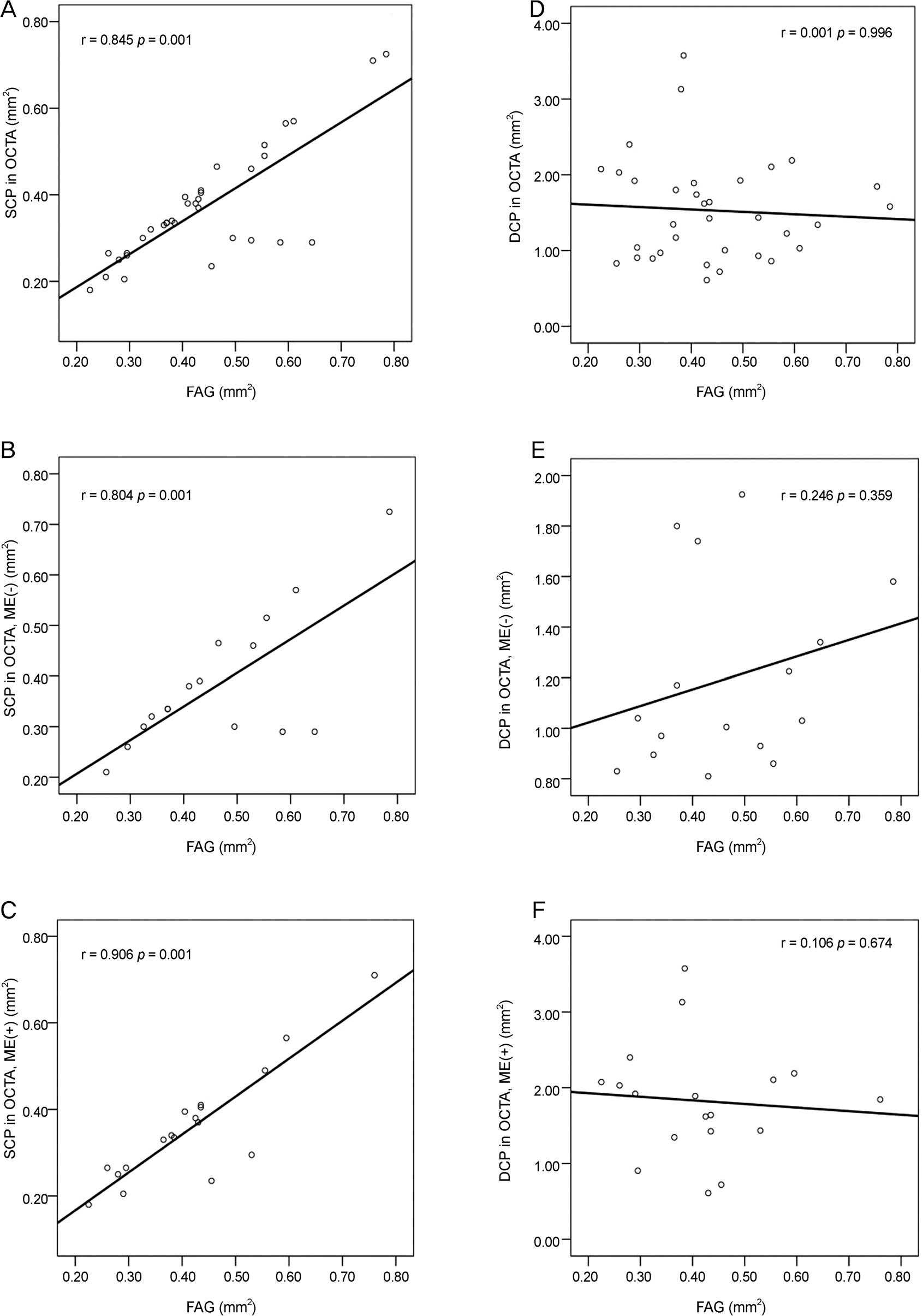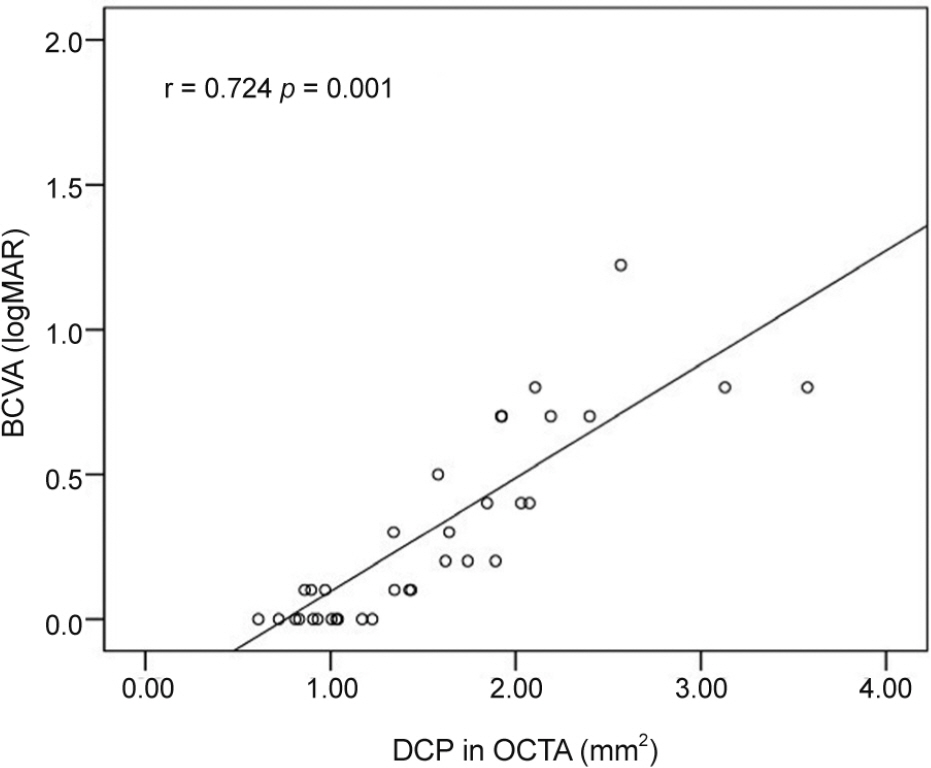J Korean Ophthalmol Soc.
2017 Jul;58(7):818-827. 10.3341/jkos.2017.58.7.818.
Efficacy of Optical Coherence Tomography Angiography in Measuring the Foveal Avascular Zone Area in Patients with Branch Retinal Vein Occlusion
- Affiliations
-
- 1Department of Ophthalmology, Ulsan University Hospital, University of Ulsan College of Medicine, Ulsan, Korea. limbus68@naver.com
- KMID: 2387156
- DOI: http://doi.org/10.3341/jkos.2017.58.7.818
Abstract
- PURPOSE
To evaluate the efficacy of optical coherence tomography angiography (OCTA) by measuring the foveal avascular zone (FAZ) area in patients with branch retinal vein occlusion (BRVO).
METHODS
Thirty four eyes of 34 patients with BRVO were retrospectively reviewed. The area of the FAZ was calculated using fluorescein angiography (FAG) and OCTA. The FAZ area was divided into two groups according to the presence of macular edema, which was determined based on the central foveal thickness (300 µm), and then the measured areas were compared.
RESULTS
Pearson's correlation analysis revealed a significant positive correlation between FAG and the superficial capillary plexus (SCP) in OCTA with or without macular edema (r = 0.845, p = 0.001). However, there was not a significant correlation between FAG and the deep capillary plexus (DCP) in OCTA (r = 0.001, p = 0.996). In addition, the FAZ area measured by FAG and OCTA in the SCP showed a significant agreement between the two methods (intraclass correlation coefficient [ICC] = 0.916, p = 0.001). However, there was no significant relation found for the FAZ area between FAG and OCTA in the DCP (ICC = 0.001, p = 0.501).
CONCLUSIONS
In the patients with BRVO, OCTA can be used to measure the FAZ areas in both the SCP and DCP, beyond measurement of the FAZ area at the two-dimensional cross section used during FAG. The FAZ area in the SCP via OCTA showed a statistically significant correlation with the FAZ area determined by FAG, but there was no such correlation in the DCP. That said, the FAZ area in the DCP was positively correlated with a decrease in visual acuity among the patients, which may be an indicator of visual prognosis.
Keyword
MeSH Terms
Figure
Reference
-
References
1. Orth DH, Patz A. Retinal branch vein occlusion. Surv Ophthalmol. 1978; 22:357–76.
Article2. Chung JH, Choi GJ, Na KS. The macular circulation state on BRVO according to occlusion site. J Korean Ophthalmol Soc. 2000; 41:1556–62.3. Kang SJ, Chin HS, Moon YS. Visual prognosis of macular edema associated with macular ischemia in branch retinal vein occlusion. J Korean Ophthalmol Soc. 2002; 43:1621–8.4. Parodi MB, Visintin F, Della Rupe P, Ravalico G. Foveal avascular zone in macular branch retinal vein occlusion. Int Ophthalmol. 1995; 19:25–8.
Article5. Wu L. Treatments for retinal vein occlusion: a review of recent developments. Retina Today. 2014; 4:62–3.6. Brown DM. Clinical implications of the BRAVO and CRUISE trials. How should physicians apply this new information in their treatment of CRVO and BRVO. Retina Today. 2010; 5:38–40.7. Yannuzzi LA, Rohrer KT, Tindel Lj. . Fluorescein angiography complication survey. Ophthalmology. 1986; 93:611–7.
Article8. Staurenghi G, Invernizzi A, de Polo L, Pellegrini M. Macular edema. Diagnosis and detection. Dev Ophthalmol. 2010; 47:27–48.9. Shrout PE, Fleiss JL. Intraclass correlations: uses in assessing rater reliability. Psychol Bull. 1979; 86:420–8.
Article10. Rogers SL, McIntosh RL, Lim L. . Natural history of branch retinal vein occlusion: an evidence-based systematic review. Ophthalmology. 2010; 117:1094–101.e5..
Article11. Fong DS, Ferris FL, Davis MD. . Causes of severe visual loss in the early treatment diabetic retinopathy study: ETDRS report no. 24. Early Treatment Diabetic Retinopathy Study Research Group. Am J Ophthalmol. 1999; 127:137–41.12. Bresnick GH, Condit R, Syrjala S. . Abnormalities of the fo-veal avascular zone in diabetic retinopathy. Arch Ophthalmol. 1984; 102:1286–93.
Article13. Arend O, Wolf S, Harris A, Reim M. The relationship of macular microcirculation to visual acuity in diabetic patients. Arch Ophthalmol. 1995; 113:610–4.
Article14. Mansour AM. Measuring fundus landmarks. Invest Ophthalmol Vis Sci. 1990; 31:41–2.15. Ryan SJ, editor. Retina, 4th ed. Los Angeles: Elsevier;2006. p. 541.16. Argon laser photocoagulation for macular edema in branch vein occlusion. The Branch vein occlusion Study group. Am J Ophtahalmol. 1984; 98:271–82.17. Arend O, Wolf S, Jung F. . Retinal microcirculation in patients with diabetes mellitus: dynamic and morphological analysis of perifoveal capillary network. Br J Ophthalmol. 1991; 75:514–8.
Article18. Lee SJ, Koh HJ. Enlargement of the foveal avascular zone in dia-betic retinopathy after adjunctive intravitreal bevacizumab (avastin) with pars plana vitrectomy. J Ocul Pharmacol Ther. 2009; 25:173–4.19. Stein MR, Parker CW. Reactions following intravenous fluorescein. Am J Ophthalmol. 1971; 72:861–8.
Article20. Karhunen U, Raitta C, Kala R. Adverse reactions to fluorescein angiography. Acta Ophthalmol (Copenh). 1986; 282–6.
Article21. Lipson BK, Yannuzzi LA. Coplication of intravenous fluorescein injections. Int Ophthalmol Clin. 1989; 29:200–5.22. Amalric P, Biau C, Féniès MT. Incidents and accidents during fluo-rescein angiography. Bull Soc Ophthalmol Fr. 1968; 68:968–73.23. Deglin SM, Deglin EA, Chung EK. Acute mycardial infacrtion fol-lowing fluorescein angiography. Heart Lung. 1977; 6:505–9.24. Cunnigham EE, Balu V. Cardiac arrest following fluorescein angiography. JAMA. 1979; 242:2431.
Article25. Wons J, Pfau M, Wirth MA. . Optical coherence tomography angiography of the foveal avascular zone in retinal vein occlusion. Ophtalmologica. 2016; 235:195–202.
Article26. Martinet V, Guigui B, Glacet-Bernard A. . Macular edema in central retinal vein occlusion: correlation between optical coher-ence tomography, angiography and visual acuity. Int Ophthalmol. 2012; 32:369–77.
Article27. Ghasemi Falavarjani K, Iafe NA, Hubschman JP. . Optical co-herence tomography angiography analysis of the foveal avascular zone and macular vessel density after anti-VEGF therapy in eyes with diabetic macular edema and retinal vein occlusion. Invest Ophthalmol Vis Sci. 2017; 58:30–4.28. Lee J, Moon BG, Cho AR, Yoon YH. Optical coherence tomog-raphy angiography of DME and its association with anti-VEGF treatment response. Ophthalmology. 2016; 123:2368–75.
Article
- Full Text Links
- Actions
-
Cited
- CITED
-
- Close
- Share
- Similar articles
-
- Retinal Capillary Network in Fellow Eyes with Unilateral Vein Occlusion Using Optical Coherence Tomography Angiography
- Correlations between Macular Microvascular Alterations and Peripheral Ischemia in Patients with Branch Retinal Vein Occlusion
- Macular Vessel Density Analysis Using Optical Coherence Tomography Angiography before and after Intravitreal Bevacizumab Injection in Branch Retinal Vein Occlusion
- Patterns of Macular Edema in Patients with Branch Retinal Vein Occlusion on Optical Coherence Tomography
- Optical Coherence Tomography-angiography: Comparison of the Foveal Avascular Zone between Diabetic Retinopathy and Normal Subjects





